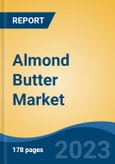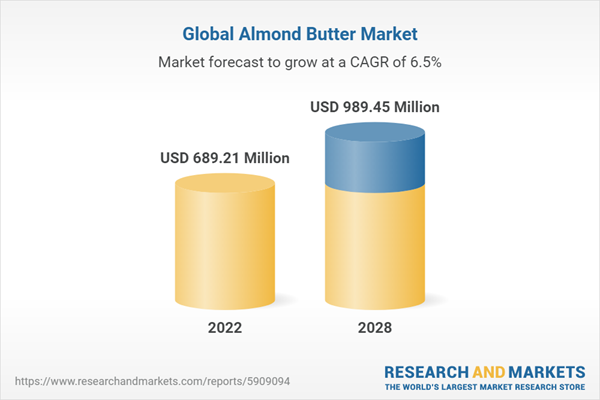Free Webex Call
The Global Almond Butter Market's valuation reached USD 689.21 million in 2022, and it is expected to exhibit substantial growth during the forecast period, with a projected Compound Annual Growth Rate (CAGR) of 6.52% through 2028. This growth is primarily driven by the rising consumer demand for healthier and natural food alternatives. Almond butter, a creamy spread derived from ground almonds, has gained popularity as a nutritious substitute for traditional peanut butter, largely attributed to the increasing awareness of almonds' health benefits, including their high content of healthy fats, protein, and vitamins. Speak directly to the analyst to clarify any post sales queries you may have.
10% Free customizationThis report comes with 10% free customization, enabling you to add data that meets your specific business needs.
One of the key drivers behind the expansion of the almond butter market is the surging interest in plant-based diets and the growth of veganism. Almond butter's versatility in various culinary applications, such as smoothies, baked goods, and savory dishes, makes it an ideal choice for health-conscious consumers. Moreover, almond butter's suitability for individuals with peanut allergies has widened its appeal, providing a safe and accessible option for a broader consumer base.
The global almond butter market is characterized by intense competition, with both established players and newcomers vying for market share. Continuous product innovation, including the introduction of flavored almond butters and convenient packaging options, continues to fuel market growth. As consumers prioritize health and wellness, the almond butter market is expected to sustain growth in the coming years, offering opportunities for businesses to cater to evolving consumer preferences and capture a share of this expanding market.
Key Market Drivers:
1. Increasing Health Consciousness: The primary driver of the almond butter market is the growing health consciousness among consumers. Almond butter provides a convenient and delicious way to incorporate the health benefits of almonds, such as healthy fats, protein, vitamins, and minerals, into one's diet. Almond butter's popularity has surged as consumers seek healthier food alternatives compared to spreads like peanut butter, which may contain higher levels of saturated fats and added sugars.2. Rise in Plant-Based Diets and Veganism: The global shift toward plant-based diets and veganism is another significant driver of the almond butter market. Almond butter, being a plant-based product rich in protein and healthy fats, aligns well with these dietary preferences. As more consumers adopt plant-based eating for ethical, environmental, and health reasons, the demand for almond butter has risen significantly, contributing to market growth.
3. Allergen-Friendly and Food Safety: Almond butter's status as a safer option for individuals with nut allergies, especially peanut allergies, has boosted its popularity. Consumers with allergies can enjoy the taste and nutritional benefits of almond butter without the risk of allergic reactions. Additionally, almond butter is often produced with stringent quality and safety standards, reassuring consumers about the product's purity and minimizing contamination risks.
4. Versatility in Culinary Applications: Another significant driver of almond butter's market growth is its versatility in culinary applications. Beyond being a simple spread, almond butter is used in a wide range of recipes and dishes, including smoothies, baking recipes, sauces, dressings, and savory dishes, adding a creamy and nutty flavor. This versatility positions almond butter as a kitchen staple, appealing to consumers looking for creative ways to incorporate healthy ingredients into their meals.
5. Product Innovation and Variety: Continuous product innovation and the proliferation of product varieties have characterized the almond butter market. Manufacturers have introduced flavored almond butters, such as honey-roasted, chocolate-infused, and spicy almond butter variants, catering to diverse taste preferences. Packaging options have evolved to include single-serve sachets, on-the-go snack packs, and squeezable tubes for convenience. These innovations have expanded the appeal of almond butter, attracting consumers of all ages and lifestyles. Furthermore, companies have ventured into organic and artisanal almond butter offerings to meet the demands of discerning customers seeking high-quality, natural, and sustainable products.
In conclusion, the global almond butter market is experiencing robust growth due to increasing health consciousness, the rise of plant-based diets and veganism, allergen-friendly attributes, culinary versatility, and ongoing product innovation. These drivers are expected to continue shaping the market's trajectory, offering opportunities for both established players and new entrants to capitalize on the growing demand for this nutritious and versatile nut-based spread. As consumer preferences evolve, the almond butter market is expected to remain dynamic, providing an array of options to cater to diverse tastes and dietary choices.
Key Market Challenges:
1. Price Volatility of Almonds: Almond butter's production is directly affected by the price and availability of almonds, which are susceptible to price fluctuations due to factors like climate conditions, supply-demand imbalances, and geopolitical issues. These price spikes can significantly impact production costs and squeeze profit margins for almond butter manufacturers. To address this challenge, businesses may need to engage in strategic sourcing, establish long-term contracts with almond suppliers, or explore alternative sources of almonds.2. Competition from Other Nut and Seed Butters: While almond butter enjoys a strong market presence, it faces stiff competition from other nut and seed butters, including peanut butter, cashew butter, and sunflower seed butter. Each of these alternatives offers unique flavor profiles and nutritional benefits, appealing to different consumer segments. Peanut butter, in particular, maintains its dominance due to its established market position and lower production costs. To overcome this challenge, almond butter producers must continuously innovate, focusing on product differentiation, unique flavors, and health benefits to maintain a competitive edge in a crowded market.
3. Supply Chain Disruptions and Sustainability Concerns: The almond butter market is vulnerable to supply chain disruptions, such as transportation bottlenecks, natural disasters, and global economic uncertainties. Recent events like the COVID-19 pandemic have highlighted the fragility of supply chains, affecting the sourcing, production, and distribution of almond butter. Additionally, sustainability concerns related to almond cultivation, such as water usage and environmental impacts, have drawn attention from consumers and regulatory authorities. Ensuring a resilient and sustainable supply chain is a challenge that almond butter manufacturers must address to maintain market stability and meet evolving consumer expectations.
4. Regulatory Compliance and Quality Assurance: The food industry, including almond butter production, is subject to stringent regulations and quality standards. Ensuring compliance with food safety regulations, labeling requirements, and quality control is an ongoing challenge. Non-compliance can result in product recalls, legal issues, and damage to a brand's reputation. Additionally, maintaining consistent product quality, flavor, and texture across batches is essential for consumer satisfaction. Meeting these regulatory and quality assurance challenges necessitates ongoing investment in quality control measures, staff training, and adherence to industry standards, adding operational complexity and costs.
5. Consumer Education and Market Saturation: While almond butter has gained popularity, there is still a need for consumer education about its benefits and uses. Many consumers may not be fully aware of the nutritional advantages of almond butter or how to incorporate it into their diets beyond a simple spread. Market saturation is also a concern as the almond butter market becomes increasingly crowded. As more brands enter the market, it becomes harder for individual companies to stand out and capture market share. Effective marketing and education strategies are essential to overcome these challenges. Companies must invest in marketing campaigns that highlight the unique selling points of their almond butter products and provide consumers with creative recipe ideas and usage suggestions.
In conclusion, the global almond butter market faces several challenges, including price volatility of almonds, competition from other nut and seed butters, supply chain disruptions, sustainability concerns, regulatory compliance, and consumer education. Overcoming these challenges requires proactive strategies, including risk mitigation, product differentiation,
supply chain resilience, quality assurance, and effective marketing. By addressing these challenges strategically, almond butter manufacturers can navigate the evolving landscape of the food industry and continue to meet the demands of health-conscious consumers worldwide.
Report Scope:
In this report, the Global Almond Butter Market has been segmented into the following categories, in addition to the industry trends which have also been detailed below:Almond Butter Market, By Nature:
- Organic
- Conventional
Almond Butter Market, By Product Type:
- Regular
- Flavored
Almond Butter Market, By Sales Channel:
- Supermarkets/Hypermarkets
- Departmental Stores
- Online
- Others
Almond Butter Market, By Region:
- Europe
- France
- Germany
- Spain
- Italy
- United Kingdom
- North America
- United States
- Canada
- Mexico
- Asia-Pacific
- China
- Japan
- India
- Vietnam
- South Korea
- Middle East & Africa
- South Africa
- Saudi Arabia
- UAE
- Turkey
- South America
- Brazil
- Argentina
- Colombia
Competitive Landscape
Company Profiles: Detailed analysis of the major companies present in the Global Almond Butter Market.Available Customizations:
Global Almond Butter Market report with the given market data, the publisher offers customizations according to a company's specific needs.This product will be delivered within 1-3 business days.
Table of Contents
1. Introduction
2. Research Methodology
3. Executive Summary
4. Voice of Customer
5. Global Almond Butter Market Outlook
6. Europe Almond Butter Market Outlook
7. North America Almond Butter Market Outlook
8. Asia-Pacific Almond Butter Market Outlook
9. Middle East & Africa Almond Butter Market Outlook
10. South America Almond Butter Market Outlook
11. Market Dynamics
12. Impact of COVID-19 on Global Almond Butter Market
14. Competitive Landscape
15. Strategic Recommendations/Action Plan
Companies Mentioned
- Hormel Foods Corporation
- Nutty Novelties
- Barney Butter
- Hallstar
- 8th Avenue Food & Provisions
- The Hain Celestial Group, Inc.
- Nuts 'N More
- Cache Creek Foods
- Once Again
- Sophim Iberia S.L.
Table Information
| Report Attribute | Details |
|---|---|
| No. of Pages | 178 |
| Published | November 2023 |
| Forecast Period | 2022 - 2028 |
| Estimated Market Value ( USD | $ 689.21 Million |
| Forecasted Market Value ( USD | $ 989.45 Million |
| Compound Annual Growth Rate | 6.5% |
| Regions Covered | Global |
| No. of Companies Mentioned | 10 |









